Awabakal Self-Definition at Local Level: Cultural Comparison
VerifiedAdded on 2020/05/04
|12
|3276
|228
Essay
AI Summary
This essay provides an in-depth analysis of the Awabakal community, focusing on their self-definition within the context of New South Wales, Australia. It explores their unique cultural practices, including religious beliefs, ceremonial life, and health practices, contrasting them with those of non-Indigenous Australians. The essay delves into the Awabakal's perspectives on death and dying, highlighting their beliefs in soul re-incarnation and burial rituals. It also examines the models and strategies the Awabakal use to fight for self-determination and self-management, particularly focusing on their spirituality and views on homosexuality. The study emphasizes the Awabakal's strong connection to the land, their geosophical worldview, and the importance of silence in their spiritual practices. The essay aims to provide a comprehensive understanding of the Awabakal's cultural identity and their ongoing efforts to maintain and assert their self-determination.
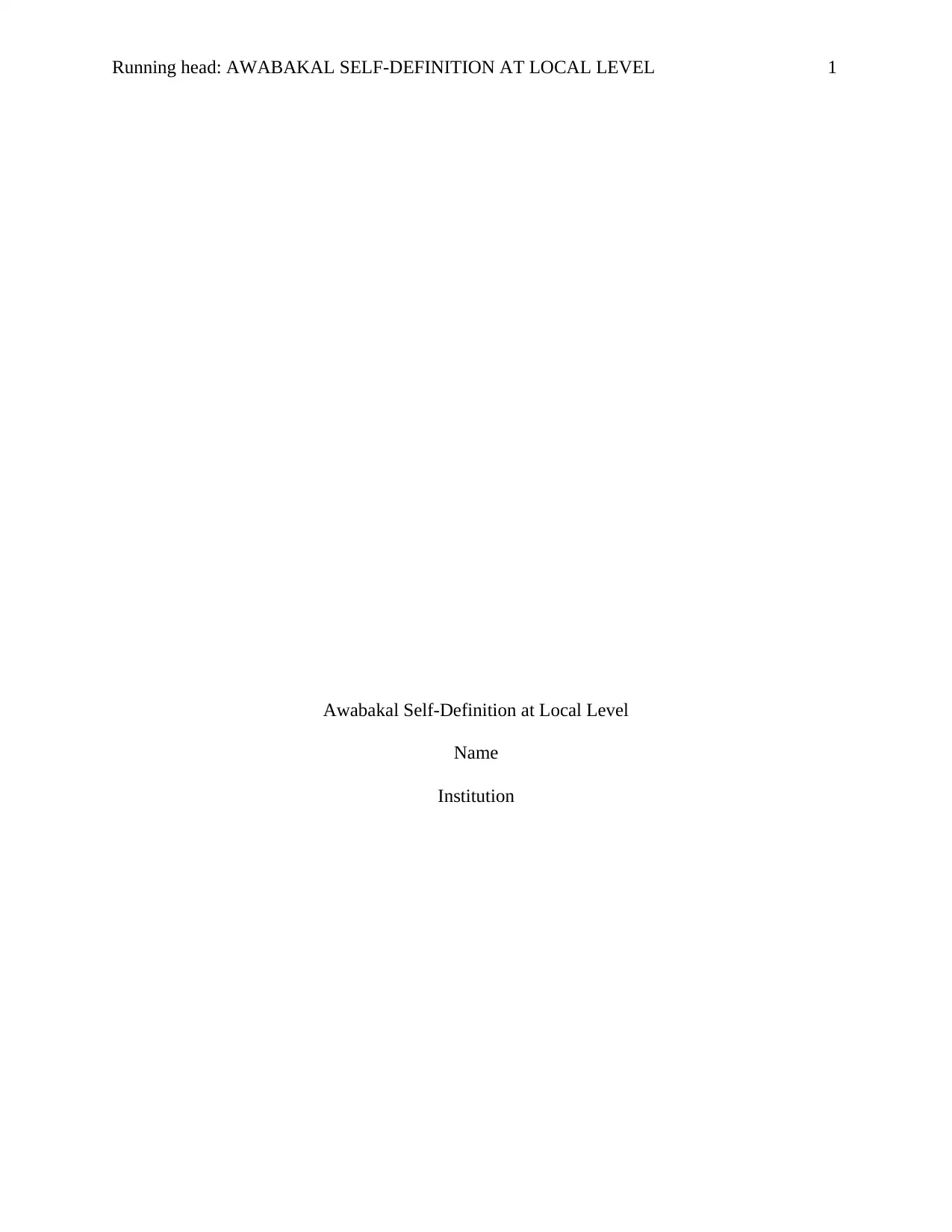
Running head: AWABAKAL SELF-DEFINITION AT LOCAL LEVEL 1
Awabakal Self-Definition at Local Level
Name
Institution
Awabakal Self-Definition at Local Level
Name
Institution
Paraphrase This Document
Need a fresh take? Get an instant paraphrase of this document with our AI Paraphraser
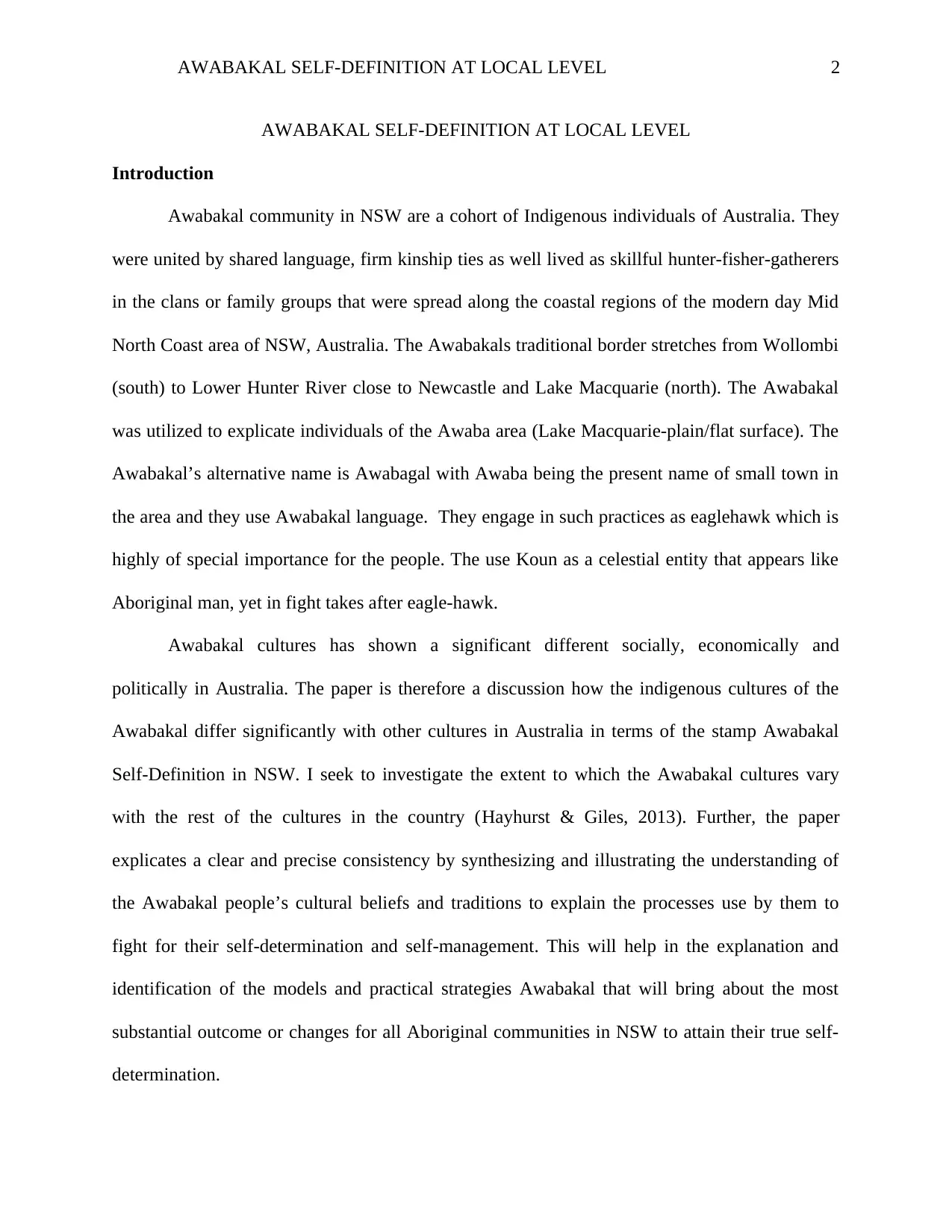
AWABAKAL SELF-DEFINITION AT LOCAL LEVEL 2
AWABAKAL SELF-DEFINITION AT LOCAL LEVEL
Introduction
Awabakal community in NSW are a cohort of Indigenous individuals of Australia. They
were united by shared language, firm kinship ties as well lived as skillful hunter-fisher-gatherers
in the clans or family groups that were spread along the coastal regions of the modern day Mid
North Coast area of NSW, Australia. The Awabakals traditional border stretches from Wollombi
(south) to Lower Hunter River close to Newcastle and Lake Macquarie (north). The Awabakal
was utilized to explicate individuals of the Awaba area (Lake Macquarie-plain/flat surface). The
Awabakal’s alternative name is Awabagal with Awaba being the present name of small town in
the area and they use Awabakal language. They engage in such practices as eaglehawk which is
highly of special importance for the people. The use Koun as a celestial entity that appears like
Aboriginal man, yet in fight takes after eagle-hawk.
Awabakal cultures has shown a significant different socially, economically and
politically in Australia. The paper is therefore a discussion how the indigenous cultures of the
Awabakal differ significantly with other cultures in Australia in terms of the stamp Awabakal
Self-Definition in NSW. I seek to investigate the extent to which the Awabakal cultures vary
with the rest of the cultures in the country (Hayhurst & Giles, 2013). Further, the paper
explicates a clear and precise consistency by synthesizing and illustrating the understanding of
the Awabakal people’s cultural beliefs and traditions to explain the processes use by them to
fight for their self-determination and self-management. This will help in the explanation and
identification of the models and practical strategies Awabakal that will bring about the most
substantial outcome or changes for all Aboriginal communities in NSW to attain their true self-
determination.
AWABAKAL SELF-DEFINITION AT LOCAL LEVEL
Introduction
Awabakal community in NSW are a cohort of Indigenous individuals of Australia. They
were united by shared language, firm kinship ties as well lived as skillful hunter-fisher-gatherers
in the clans or family groups that were spread along the coastal regions of the modern day Mid
North Coast area of NSW, Australia. The Awabakals traditional border stretches from Wollombi
(south) to Lower Hunter River close to Newcastle and Lake Macquarie (north). The Awabakal
was utilized to explicate individuals of the Awaba area (Lake Macquarie-plain/flat surface). The
Awabakal’s alternative name is Awabagal with Awaba being the present name of small town in
the area and they use Awabakal language. They engage in such practices as eaglehawk which is
highly of special importance for the people. The use Koun as a celestial entity that appears like
Aboriginal man, yet in fight takes after eagle-hawk.
Awabakal cultures has shown a significant different socially, economically and
politically in Australia. The paper is therefore a discussion how the indigenous cultures of the
Awabakal differ significantly with other cultures in Australia in terms of the stamp Awabakal
Self-Definition in NSW. I seek to investigate the extent to which the Awabakal cultures vary
with the rest of the cultures in the country (Hayhurst & Giles, 2013). Further, the paper
explicates a clear and precise consistency by synthesizing and illustrating the understanding of
the Awabakal people’s cultural beliefs and traditions to explain the processes use by them to
fight for their self-determination and self-management. This will help in the explanation and
identification of the models and practical strategies Awabakal that will bring about the most
substantial outcome or changes for all Aboriginal communities in NSW to attain their true self-
determination.
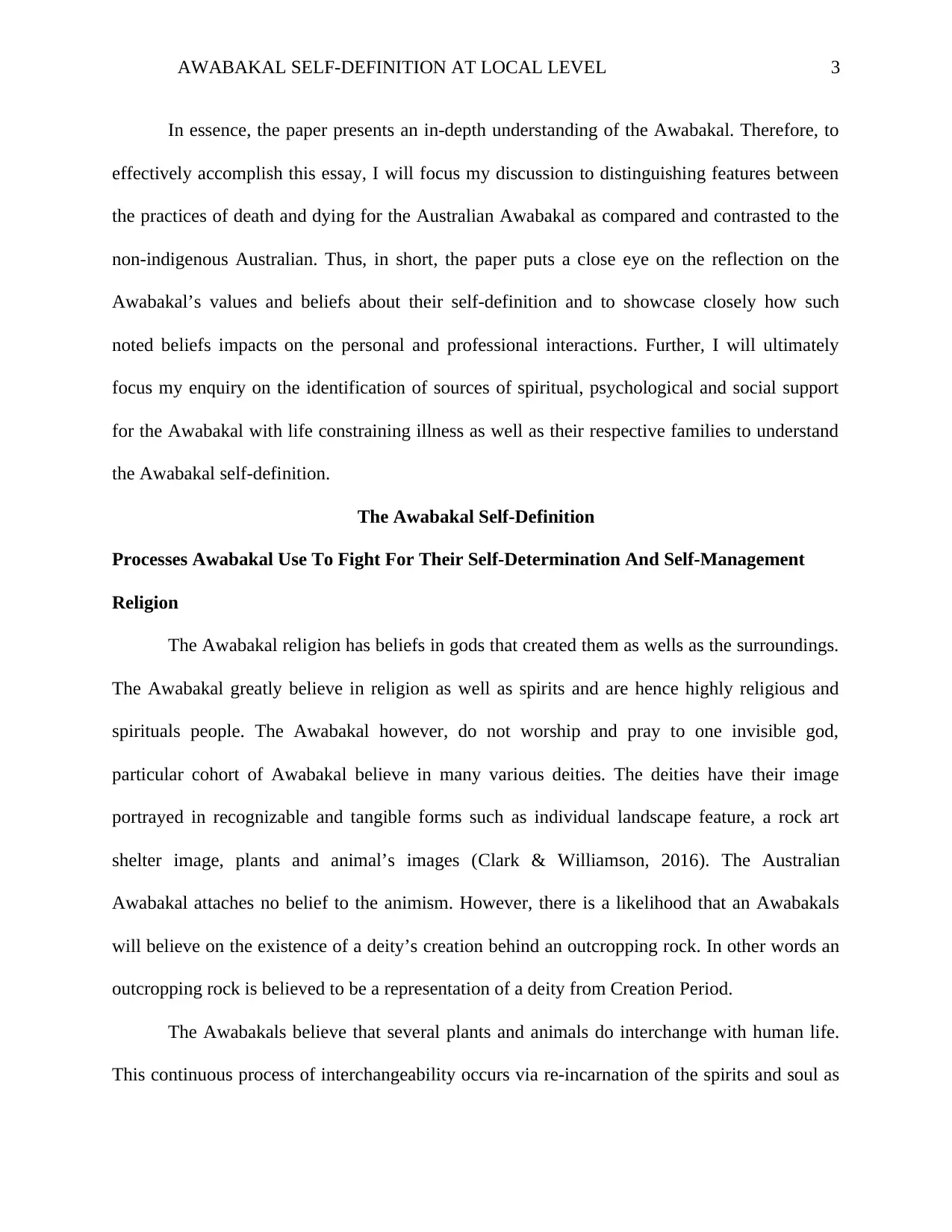
AWABAKAL SELF-DEFINITION AT LOCAL LEVEL 3
In essence, the paper presents an in-depth understanding of the Awabakal. Therefore, to
effectively accomplish this essay, I will focus my discussion to distinguishing features between
the practices of death and dying for the Australian Awabakal as compared and contrasted to the
non-indigenous Australian. Thus, in short, the paper puts a close eye on the reflection on the
Awabakal’s values and beliefs about their self-definition and to showcase closely how such
noted beliefs impacts on the personal and professional interactions. Further, I will ultimately
focus my enquiry on the identification of sources of spiritual, psychological and social support
for the Awabakal with life constraining illness as well as their respective families to understand
the Awabakal self-definition.
The Awabakal Self-Definition
Processes Awabakal Use To Fight For Their Self-Determination And Self-Management
Religion
The Awabakal religion has beliefs in gods that created them as wells as the surroundings.
The Awabakal greatly believe in religion as well as spirits and are hence highly religious and
spirituals people. The Awabakal however, do not worship and pray to one invisible god,
particular cohort of Awabakal believe in many various deities. The deities have their image
portrayed in recognizable and tangible forms such as individual landscape feature, a rock art
shelter image, plants and animal’s images (Clark & Williamson, 2016). The Australian
Awabakal attaches no belief to the animism. However, there is a likelihood that an Awabakals
will believe on the existence of a deity’s creation behind an outcropping rock. In other words an
outcropping rock is believed to be a representation of a deity from Creation Period.
The Awabakals believe that several plants and animals do interchange with human life.
This continuous process of interchangeability occurs via re-incarnation of the spirits and soul as
In essence, the paper presents an in-depth understanding of the Awabakal. Therefore, to
effectively accomplish this essay, I will focus my discussion to distinguishing features between
the practices of death and dying for the Australian Awabakal as compared and contrasted to the
non-indigenous Australian. Thus, in short, the paper puts a close eye on the reflection on the
Awabakal’s values and beliefs about their self-definition and to showcase closely how such
noted beliefs impacts on the personal and professional interactions. Further, I will ultimately
focus my enquiry on the identification of sources of spiritual, psychological and social support
for the Awabakal with life constraining illness as well as their respective families to understand
the Awabakal self-definition.
The Awabakal Self-Definition
Processes Awabakal Use To Fight For Their Self-Determination And Self-Management
Religion
The Awabakal religion has beliefs in gods that created them as wells as the surroundings.
The Awabakal greatly believe in religion as well as spirits and are hence highly religious and
spirituals people. The Awabakal however, do not worship and pray to one invisible god,
particular cohort of Awabakal believe in many various deities. The deities have their image
portrayed in recognizable and tangible forms such as individual landscape feature, a rock art
shelter image, plants and animal’s images (Clark & Williamson, 2016). The Australian
Awabakal attaches no belief to the animism. However, there is a likelihood that an Awabakals
will believe on the existence of a deity’s creation behind an outcropping rock. In other words an
outcropping rock is believed to be a representation of a deity from Creation Period.
The Awabakals believe that several plants and animals do interchange with human life.
This continuous process of interchangeability occurs via re-incarnation of the spirits and soul as
⊘ This is a preview!⊘
Do you want full access?
Subscribe today to unlock all pages.

Trusted by 1+ million students worldwide
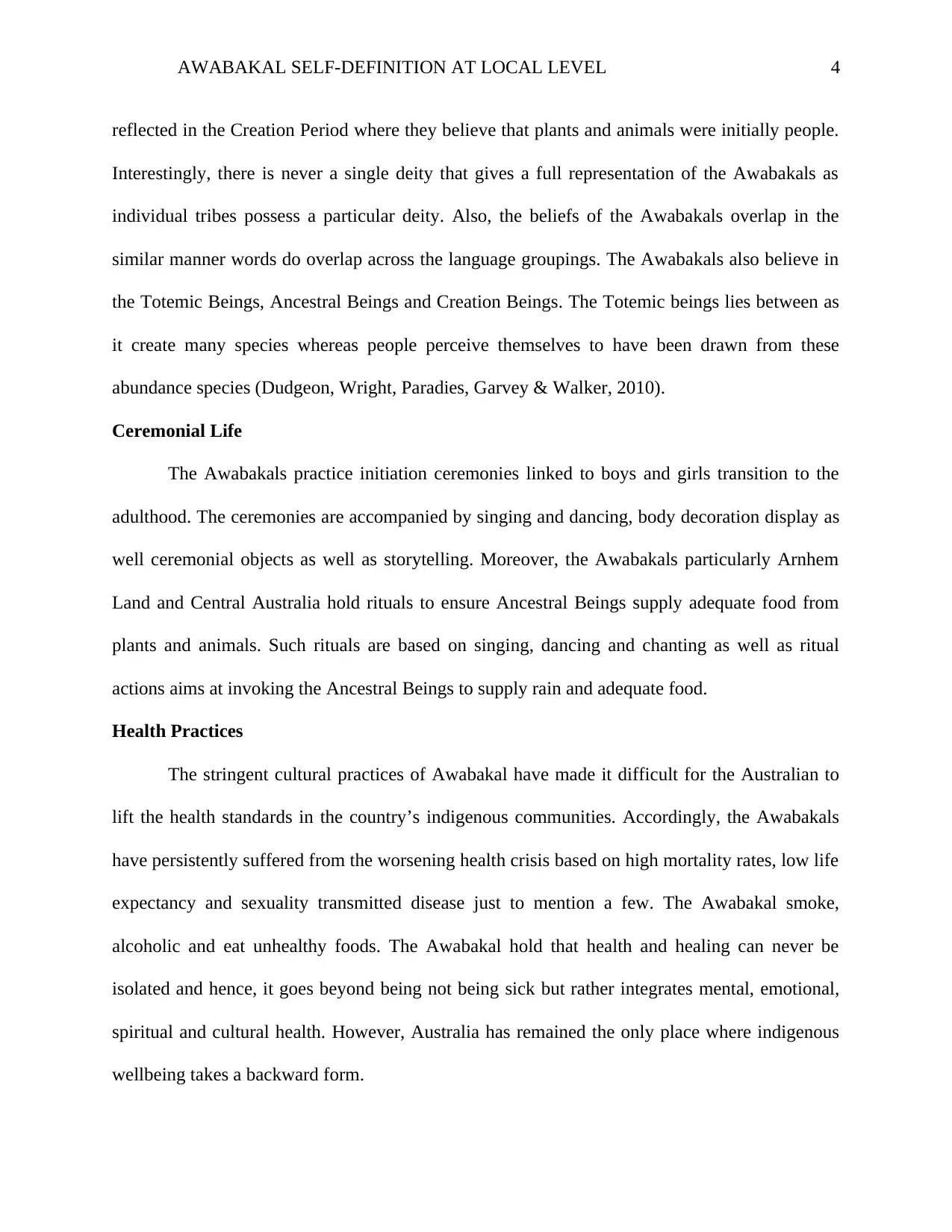
AWABAKAL SELF-DEFINITION AT LOCAL LEVEL 4
reflected in the Creation Period where they believe that plants and animals were initially people.
Interestingly, there is never a single deity that gives a full representation of the Awabakals as
individual tribes possess a particular deity. Also, the beliefs of the Awabakals overlap in the
similar manner words do overlap across the language groupings. The Awabakals also believe in
the Totemic Beings, Ancestral Beings and Creation Beings. The Totemic beings lies between as
it create many species whereas people perceive themselves to have been drawn from these
abundance species (Dudgeon, Wright, Paradies, Garvey & Walker, 2010).
Ceremonial Life
The Awabakals practice initiation ceremonies linked to boys and girls transition to the
adulthood. The ceremonies are accompanied by singing and dancing, body decoration display as
well ceremonial objects as well as storytelling. Moreover, the Awabakals particularly Arnhem
Land and Central Australia hold rituals to ensure Ancestral Beings supply adequate food from
plants and animals. Such rituals are based on singing, dancing and chanting as well as ritual
actions aims at invoking the Ancestral Beings to supply rain and adequate food.
Health Practices
The stringent cultural practices of Awabakal have made it difficult for the Australian to
lift the health standards in the country’s indigenous communities. Accordingly, the Awabakals
have persistently suffered from the worsening health crisis based on high mortality rates, low life
expectancy and sexuality transmitted disease just to mention a few. The Awabakal smoke,
alcoholic and eat unhealthy foods. The Awabakal hold that health and healing can never be
isolated and hence, it goes beyond being not being sick but rather integrates mental, emotional,
spiritual and cultural health. However, Australia has remained the only place where indigenous
wellbeing takes a backward form.
reflected in the Creation Period where they believe that plants and animals were initially people.
Interestingly, there is never a single deity that gives a full representation of the Awabakals as
individual tribes possess a particular deity. Also, the beliefs of the Awabakals overlap in the
similar manner words do overlap across the language groupings. The Awabakals also believe in
the Totemic Beings, Ancestral Beings and Creation Beings. The Totemic beings lies between as
it create many species whereas people perceive themselves to have been drawn from these
abundance species (Dudgeon, Wright, Paradies, Garvey & Walker, 2010).
Ceremonial Life
The Awabakals practice initiation ceremonies linked to boys and girls transition to the
adulthood. The ceremonies are accompanied by singing and dancing, body decoration display as
well ceremonial objects as well as storytelling. Moreover, the Awabakals particularly Arnhem
Land and Central Australia hold rituals to ensure Ancestral Beings supply adequate food from
plants and animals. Such rituals are based on singing, dancing and chanting as well as ritual
actions aims at invoking the Ancestral Beings to supply rain and adequate food.
Health Practices
The stringent cultural practices of Awabakal have made it difficult for the Australian to
lift the health standards in the country’s indigenous communities. Accordingly, the Awabakals
have persistently suffered from the worsening health crisis based on high mortality rates, low life
expectancy and sexuality transmitted disease just to mention a few. The Awabakal smoke,
alcoholic and eat unhealthy foods. The Awabakal hold that health and healing can never be
isolated and hence, it goes beyond being not being sick but rather integrates mental, emotional,
spiritual and cultural health. However, Australia has remained the only place where indigenous
wellbeing takes a backward form.
Paraphrase This Document
Need a fresh take? Get an instant paraphrase of this document with our AI Paraphraser
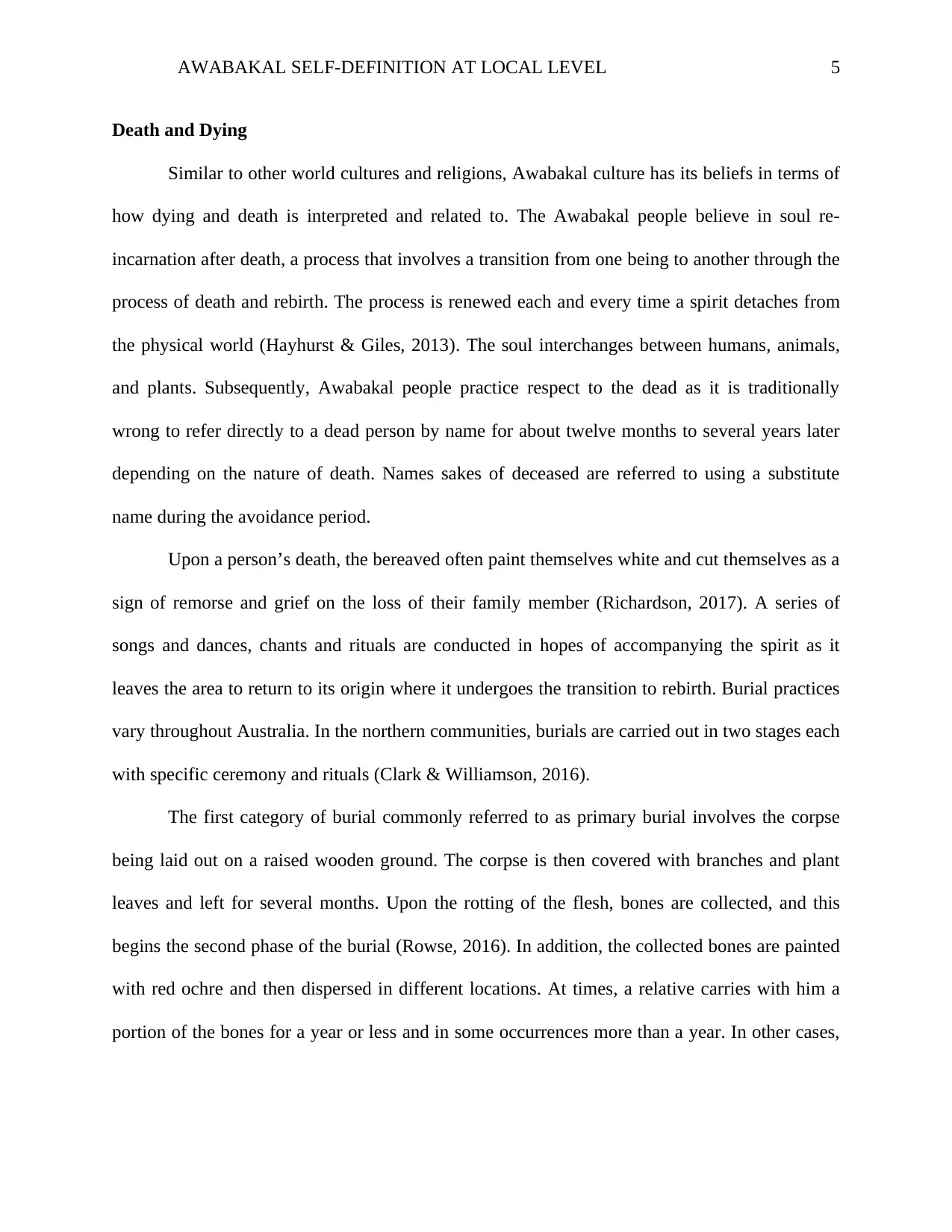
AWABAKAL SELF-DEFINITION AT LOCAL LEVEL 5
Death and Dying
Similar to other world cultures and religions, Awabakal culture has its beliefs in terms of
how dying and death is interpreted and related to. The Awabakal people believe in soul re-
incarnation after death, a process that involves a transition from one being to another through the
process of death and rebirth. The process is renewed each and every time a spirit detaches from
the physical world (Hayhurst & Giles, 2013). The soul interchanges between humans, animals,
and plants. Subsequently, Awabakal people practice respect to the dead as it is traditionally
wrong to refer directly to a dead person by name for about twelve months to several years later
depending on the nature of death. Names sakes of deceased are referred to using a substitute
name during the avoidance period.
Upon a person’s death, the bereaved often paint themselves white and cut themselves as a
sign of remorse and grief on the loss of their family member (Richardson, 2017). A series of
songs and dances, chants and rituals are conducted in hopes of accompanying the spirit as it
leaves the area to return to its origin where it undergoes the transition to rebirth. Burial practices
vary throughout Australia. In the northern communities, burials are carried out in two stages each
with specific ceremony and rituals (Clark & Williamson, 2016).
The first category of burial commonly referred to as primary burial involves the corpse
being laid out on a raised wooden ground. The corpse is then covered with branches and plant
leaves and left for several months. Upon the rotting of the flesh, bones are collected, and this
begins the second phase of the burial (Rowse, 2016). In addition, the collected bones are painted
with red ochre and then dispersed in different locations. At times, a relative carries with him a
portion of the bones for a year or less and in some occurrences more than a year. In other cases,
Death and Dying
Similar to other world cultures and religions, Awabakal culture has its beliefs in terms of
how dying and death is interpreted and related to. The Awabakal people believe in soul re-
incarnation after death, a process that involves a transition from one being to another through the
process of death and rebirth. The process is renewed each and every time a spirit detaches from
the physical world (Hayhurst & Giles, 2013). The soul interchanges between humans, animals,
and plants. Subsequently, Awabakal people practice respect to the dead as it is traditionally
wrong to refer directly to a dead person by name for about twelve months to several years later
depending on the nature of death. Names sakes of deceased are referred to using a substitute
name during the avoidance period.
Upon a person’s death, the bereaved often paint themselves white and cut themselves as a
sign of remorse and grief on the loss of their family member (Richardson, 2017). A series of
songs and dances, chants and rituals are conducted in hopes of accompanying the spirit as it
leaves the area to return to its origin where it undergoes the transition to rebirth. Burial practices
vary throughout Australia. In the northern communities, burials are carried out in two stages each
with specific ceremony and rituals (Clark & Williamson, 2016).
The first category of burial commonly referred to as primary burial involves the corpse
being laid out on a raised wooden ground. The corpse is then covered with branches and plant
leaves and left for several months. Upon the rotting of the flesh, bones are collected, and this
begins the second phase of the burial (Rowse, 2016). In addition, the collected bones are painted
with red ochre and then dispersed in different locations. At times, a relative carries with him a
portion of the bones for a year or less and in some occurrences more than a year. In other cases,
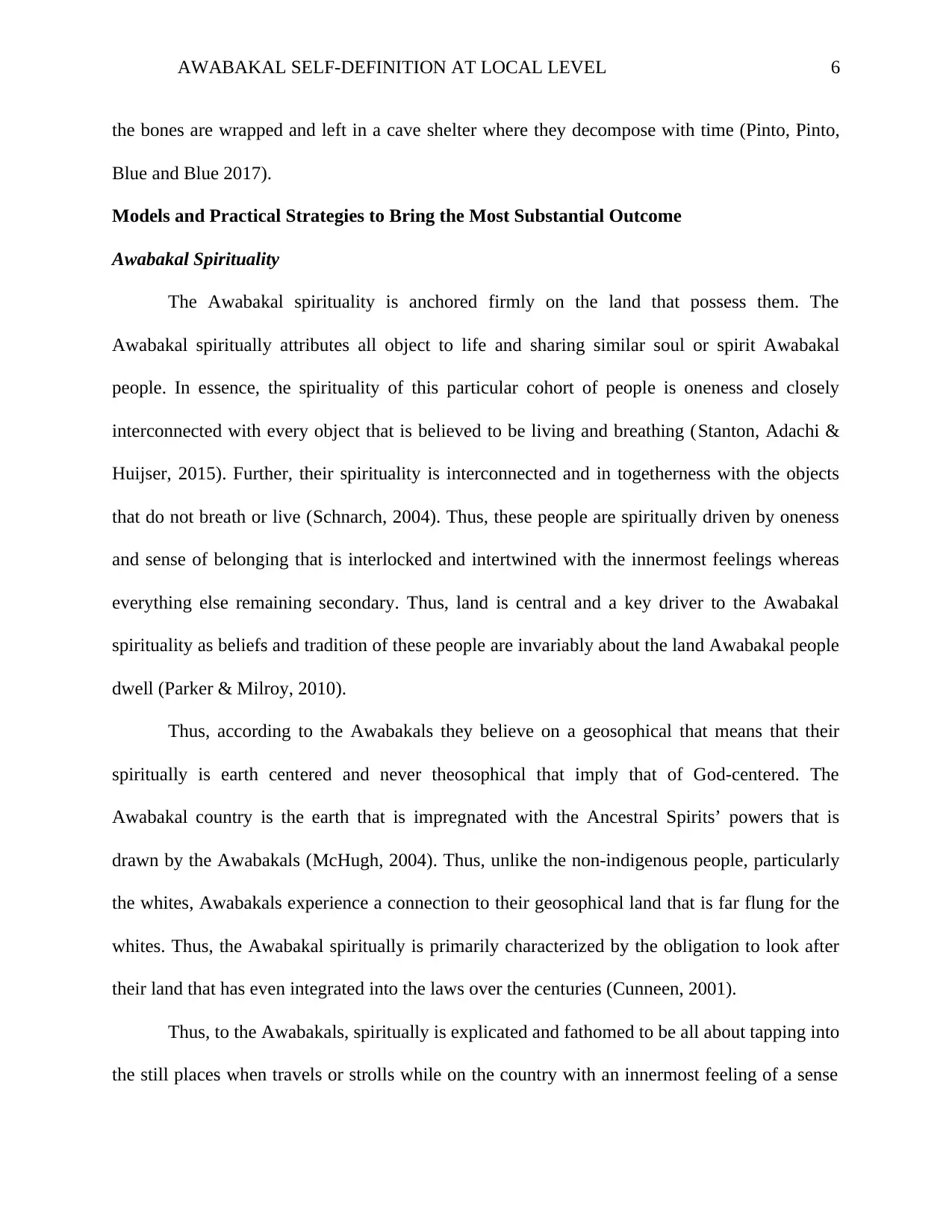
AWABAKAL SELF-DEFINITION AT LOCAL LEVEL 6
the bones are wrapped and left in a cave shelter where they decompose with time (Pinto, Pinto,
Blue and Blue 2017).
Models and Practical Strategies to Bring the Most Substantial Outcome
Awabakal Spirituality
The Awabakal spirituality is anchored firmly on the land that possess them. The
Awabakal spiritually attributes all object to life and sharing similar soul or spirit Awabakal
people. In essence, the spirituality of this particular cohort of people is oneness and closely
interconnected with every object that is believed to be living and breathing (Stanton, Adachi &
Huijser, 2015). Further, their spirituality is interconnected and in togetherness with the objects
that do not breath or live (Schnarch, 2004). Thus, these people are spiritually driven by oneness
and sense of belonging that is interlocked and intertwined with the innermost feelings whereas
everything else remaining secondary. Thus, land is central and a key driver to the Awabakal
spirituality as beliefs and tradition of these people are invariably about the land Awabakal people
dwell (Parker & Milroy, 2010).
Thus, according to the Awabakals they believe on a geosophical that means that their
spiritually is earth centered and never theosophical that imply that of God-centered. The
Awabakal country is the earth that is impregnated with the Ancestral Spirits’ powers that is
drawn by the Awabakals (McHugh, 2004). Thus, unlike the non-indigenous people, particularly
the whites, Awabakals experience a connection to their geosophical land that is far flung for the
whites. Thus, the Awabakal spiritually is primarily characterized by the obligation to look after
their land that has even integrated into the laws over the centuries (Cunneen, 2001).
Thus, to the Awabakals, spiritually is explicated and fathomed to be all about tapping into
the still places when travels or strolls while on the country with an innermost feeling of a sense
the bones are wrapped and left in a cave shelter where they decompose with time (Pinto, Pinto,
Blue and Blue 2017).
Models and Practical Strategies to Bring the Most Substantial Outcome
Awabakal Spirituality
The Awabakal spirituality is anchored firmly on the land that possess them. The
Awabakal spiritually attributes all object to life and sharing similar soul or spirit Awabakal
people. In essence, the spirituality of this particular cohort of people is oneness and closely
interconnected with every object that is believed to be living and breathing (Stanton, Adachi &
Huijser, 2015). Further, their spirituality is interconnected and in togetherness with the objects
that do not breath or live (Schnarch, 2004). Thus, these people are spiritually driven by oneness
and sense of belonging that is interlocked and intertwined with the innermost feelings whereas
everything else remaining secondary. Thus, land is central and a key driver to the Awabakal
spirituality as beliefs and tradition of these people are invariably about the land Awabakal people
dwell (Parker & Milroy, 2010).
Thus, according to the Awabakals they believe on a geosophical that means that their
spiritually is earth centered and never theosophical that imply that of God-centered. The
Awabakal country is the earth that is impregnated with the Ancestral Spirits’ powers that is
drawn by the Awabakals (McHugh, 2004). Thus, unlike the non-indigenous people, particularly
the whites, Awabakals experience a connection to their geosophical land that is far flung for the
whites. Thus, the Awabakal spiritually is primarily characterized by the obligation to look after
their land that has even integrated into the laws over the centuries (Cunneen, 2001).
Thus, to the Awabakals, spiritually is explicated and fathomed to be all about tapping into
the still places when travels or strolls while on the country with an innermost feeling of a sense
⊘ This is a preview!⊘
Do you want full access?
Subscribe today to unlock all pages.

Trusted by 1+ million students worldwide
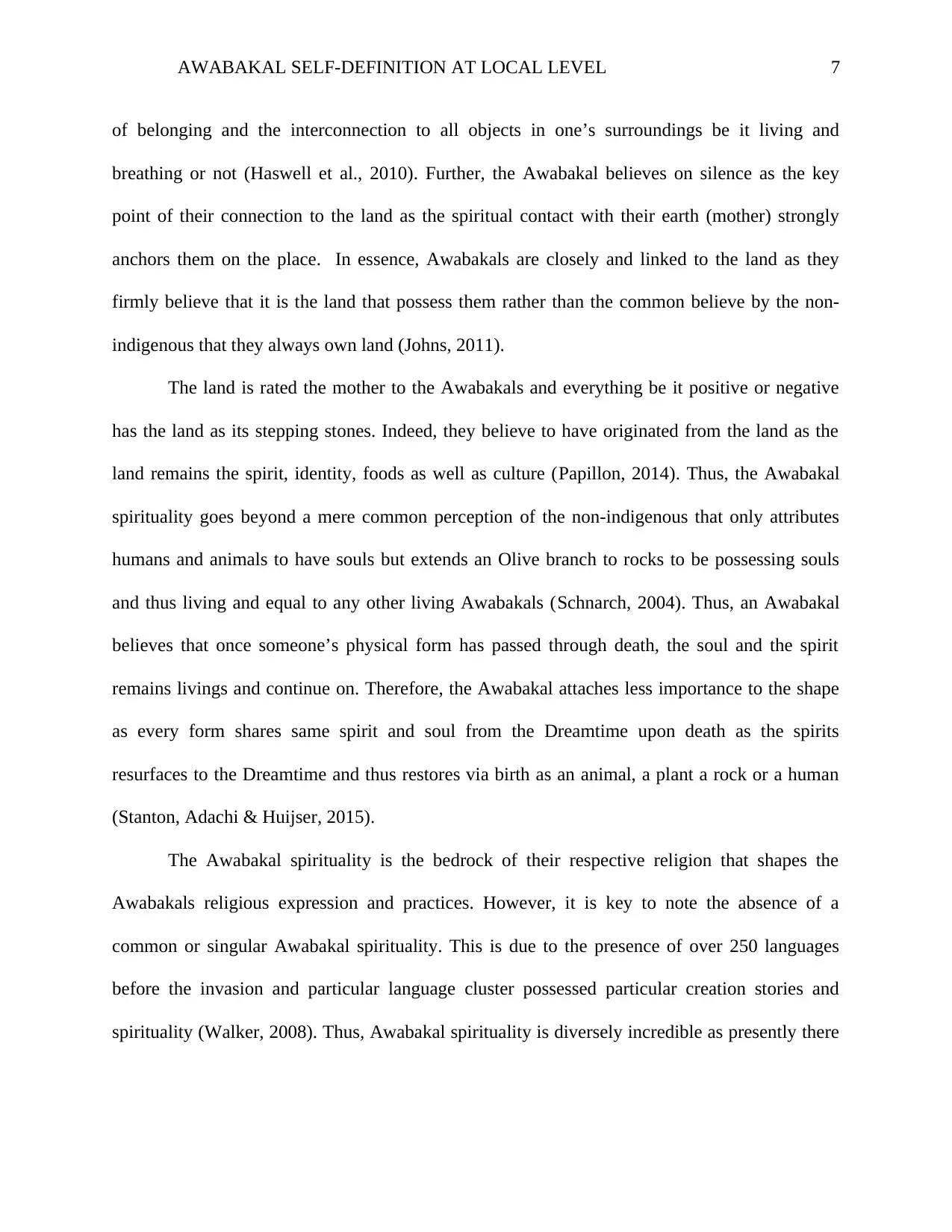
AWABAKAL SELF-DEFINITION AT LOCAL LEVEL 7
of belonging and the interconnection to all objects in one’s surroundings be it living and
breathing or not (Haswell et al., 2010). Further, the Awabakal believes on silence as the key
point of their connection to the land as the spiritual contact with their earth (mother) strongly
anchors them on the place. In essence, Awabakals are closely and linked to the land as they
firmly believe that it is the land that possess them rather than the common believe by the non-
indigenous that they always own land (Johns, 2011).
The land is rated the mother to the Awabakals and everything be it positive or negative
has the land as its stepping stones. Indeed, they believe to have originated from the land as the
land remains the spirit, identity, foods as well as culture (Papillon, 2014). Thus, the Awabakal
spirituality goes beyond a mere common perception of the non-indigenous that only attributes
humans and animals to have souls but extends an Olive branch to rocks to be possessing souls
and thus living and equal to any other living Awabakals (Schnarch, 2004). Thus, an Awabakal
believes that once someone’s physical form has passed through death, the soul and the spirit
remains livings and continue on. Therefore, the Awabakal attaches less importance to the shape
as every form shares same spirit and soul from the Dreamtime upon death as the spirits
resurfaces to the Dreamtime and thus restores via birth as an animal, a plant a rock or a human
(Stanton, Adachi & Huijser, 2015).
The Awabakal spirituality is the bedrock of their respective religion that shapes the
Awabakals religious expression and practices. However, it is key to note the absence of a
common or singular Awabakal spirituality. This is due to the presence of over 250 languages
before the invasion and particular language cluster possessed particular creation stories and
spirituality (Walker, 2008). Thus, Awabakal spirituality is diversely incredible as presently there
of belonging and the interconnection to all objects in one’s surroundings be it living and
breathing or not (Haswell et al., 2010). Further, the Awabakal believes on silence as the key
point of their connection to the land as the spiritual contact with their earth (mother) strongly
anchors them on the place. In essence, Awabakals are closely and linked to the land as they
firmly believe that it is the land that possess them rather than the common believe by the non-
indigenous that they always own land (Johns, 2011).
The land is rated the mother to the Awabakals and everything be it positive or negative
has the land as its stepping stones. Indeed, they believe to have originated from the land as the
land remains the spirit, identity, foods as well as culture (Papillon, 2014). Thus, the Awabakal
spirituality goes beyond a mere common perception of the non-indigenous that only attributes
humans and animals to have souls but extends an Olive branch to rocks to be possessing souls
and thus living and equal to any other living Awabakals (Schnarch, 2004). Thus, an Awabakal
believes that once someone’s physical form has passed through death, the soul and the spirit
remains livings and continue on. Therefore, the Awabakal attaches less importance to the shape
as every form shares same spirit and soul from the Dreamtime upon death as the spirits
resurfaces to the Dreamtime and thus restores via birth as an animal, a plant a rock or a human
(Stanton, Adachi & Huijser, 2015).
The Awabakal spirituality is the bedrock of their respective religion that shapes the
Awabakals religious expression and practices. However, it is key to note the absence of a
common or singular Awabakal spirituality. This is due to the presence of over 250 languages
before the invasion and particular language cluster possessed particular creation stories and
spirituality (Walker, 2008). Thus, Awabakal spirituality is diversely incredible as presently there
Paraphrase This Document
Need a fresh take? Get an instant paraphrase of this document with our AI Paraphraser
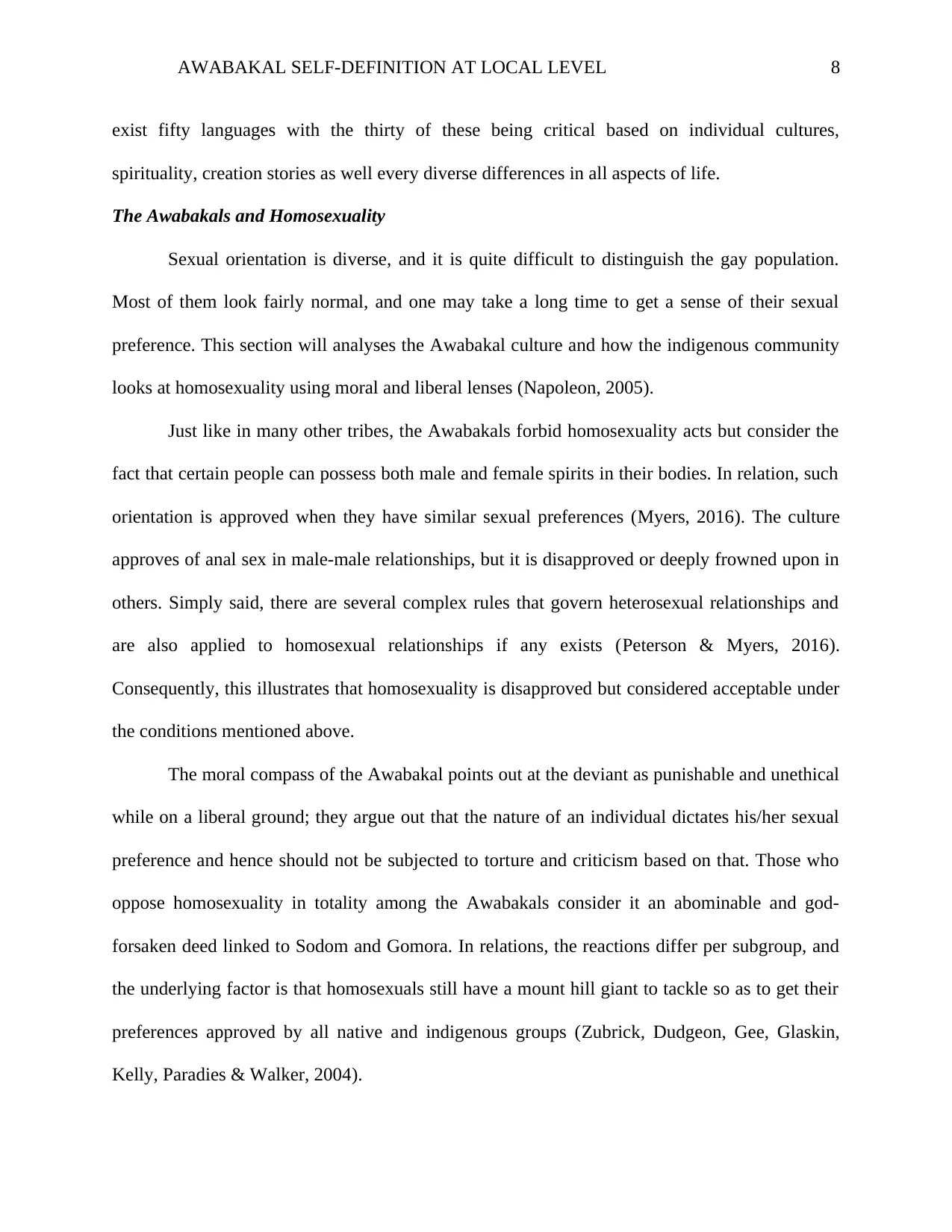
AWABAKAL SELF-DEFINITION AT LOCAL LEVEL 8
exist fifty languages with the thirty of these being critical based on individual cultures,
spirituality, creation stories as well every diverse differences in all aspects of life.
The Awabakals and Homosexuality
Sexual orientation is diverse, and it is quite difficult to distinguish the gay population.
Most of them look fairly normal, and one may take a long time to get a sense of their sexual
preference. This section will analyses the Awabakal culture and how the indigenous community
looks at homosexuality using moral and liberal lenses (Napoleon, 2005).
Just like in many other tribes, the Awabakals forbid homosexuality acts but consider the
fact that certain people can possess both male and female spirits in their bodies. In relation, such
orientation is approved when they have similar sexual preferences (Myers, 2016). The culture
approves of anal sex in male-male relationships, but it is disapproved or deeply frowned upon in
others. Simply said, there are several complex rules that govern heterosexual relationships and
are also applied to homosexual relationships if any exists (Peterson & Myers, 2016).
Consequently, this illustrates that homosexuality is disapproved but considered acceptable under
the conditions mentioned above.
The moral compass of the Awabakal points out at the deviant as punishable and unethical
while on a liberal ground; they argue out that the nature of an individual dictates his/her sexual
preference and hence should not be subjected to torture and criticism based on that. Those who
oppose homosexuality in totality among the Awabakals consider it an abominable and god-
forsaken deed linked to Sodom and Gomora. In relations, the reactions differ per subgroup, and
the underlying factor is that homosexuals still have a mount hill giant to tackle so as to get their
preferences approved by all native and indigenous groups (Zubrick, Dudgeon, Gee, Glaskin,
Kelly, Paradies & Walker, 2004).
exist fifty languages with the thirty of these being critical based on individual cultures,
spirituality, creation stories as well every diverse differences in all aspects of life.
The Awabakals and Homosexuality
Sexual orientation is diverse, and it is quite difficult to distinguish the gay population.
Most of them look fairly normal, and one may take a long time to get a sense of their sexual
preference. This section will analyses the Awabakal culture and how the indigenous community
looks at homosexuality using moral and liberal lenses (Napoleon, 2005).
Just like in many other tribes, the Awabakals forbid homosexuality acts but consider the
fact that certain people can possess both male and female spirits in their bodies. In relation, such
orientation is approved when they have similar sexual preferences (Myers, 2016). The culture
approves of anal sex in male-male relationships, but it is disapproved or deeply frowned upon in
others. Simply said, there are several complex rules that govern heterosexual relationships and
are also applied to homosexual relationships if any exists (Peterson & Myers, 2016).
Consequently, this illustrates that homosexuality is disapproved but considered acceptable under
the conditions mentioned above.
The moral compass of the Awabakal points out at the deviant as punishable and unethical
while on a liberal ground; they argue out that the nature of an individual dictates his/her sexual
preference and hence should not be subjected to torture and criticism based on that. Those who
oppose homosexuality in totality among the Awabakals consider it an abominable and god-
forsaken deed linked to Sodom and Gomora. In relations, the reactions differ per subgroup, and
the underlying factor is that homosexuals still have a mount hill giant to tackle so as to get their
preferences approved by all native and indigenous groups (Zubrick, Dudgeon, Gee, Glaskin,
Kelly, Paradies & Walker, 2004).
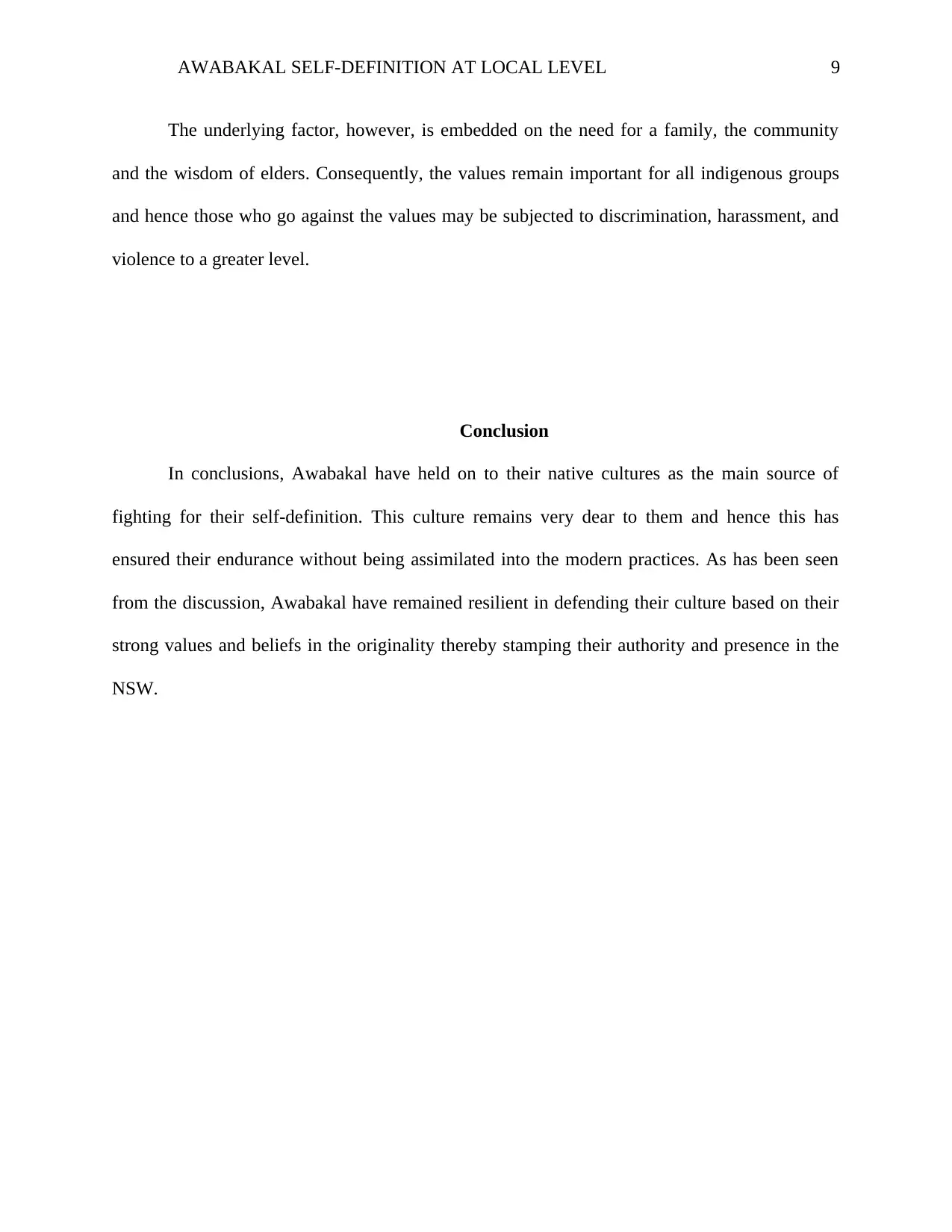
AWABAKAL SELF-DEFINITION AT LOCAL LEVEL 9
The underlying factor, however, is embedded on the need for a family, the community
and the wisdom of elders. Consequently, the values remain important for all indigenous groups
and hence those who go against the values may be subjected to discrimination, harassment, and
violence to a greater level.
Conclusion
In conclusions, Awabakal have held on to their native cultures as the main source of
fighting for their self-definition. This culture remains very dear to them and hence this has
ensured their endurance without being assimilated into the modern practices. As has been seen
from the discussion, Awabakal have remained resilient in defending their culture based on their
strong values and beliefs in the originality thereby stamping their authority and presence in the
NSW.
The underlying factor, however, is embedded on the need for a family, the community
and the wisdom of elders. Consequently, the values remain important for all indigenous groups
and hence those who go against the values may be subjected to discrimination, harassment, and
violence to a greater level.
Conclusion
In conclusions, Awabakal have held on to their native cultures as the main source of
fighting for their self-definition. This culture remains very dear to them and hence this has
ensured their endurance without being assimilated into the modern practices. As has been seen
from the discussion, Awabakal have remained resilient in defending their culture based on their
strong values and beliefs in the originality thereby stamping their authority and presence in the
NSW.
⊘ This is a preview!⊘
Do you want full access?
Subscribe today to unlock all pages.

Trusted by 1+ million students worldwide
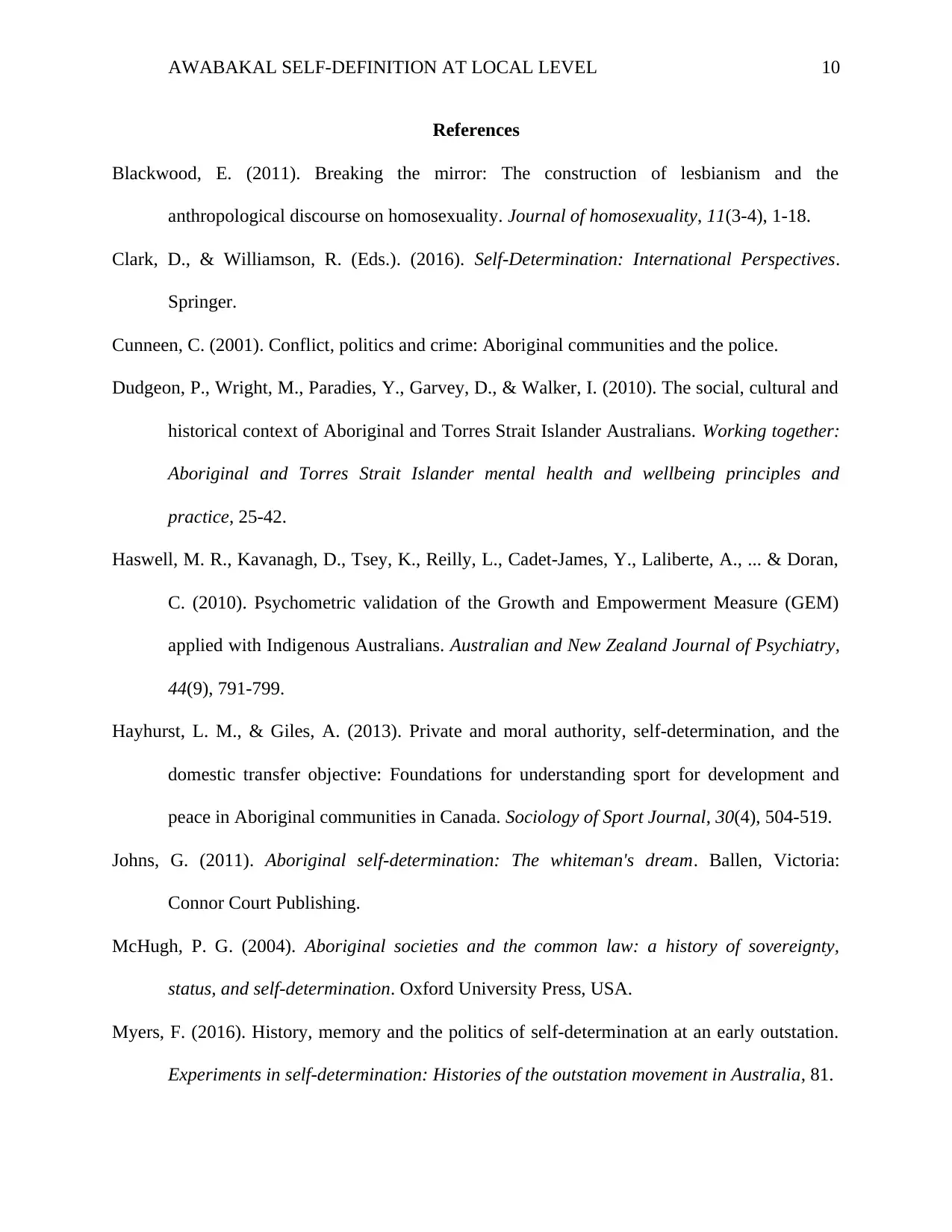
AWABAKAL SELF-DEFINITION AT LOCAL LEVEL 10
References
Blackwood, E. (2011). Breaking the mirror: The construction of lesbianism and the
anthropological discourse on homosexuality. Journal of homosexuality, 11(3-4), 1-18.
Clark, D., & Williamson, R. (Eds.). (2016). Self-Determination: International Perspectives.
Springer.
Cunneen, C. (2001). Conflict, politics and crime: Aboriginal communities and the police.
Dudgeon, P., Wright, M., Paradies, Y., Garvey, D., & Walker, I. (2010). The social, cultural and
historical context of Aboriginal and Torres Strait Islander Australians. Working together:
Aboriginal and Torres Strait Islander mental health and wellbeing principles and
practice, 25-42.
Haswell, M. R., Kavanagh, D., Tsey, K., Reilly, L., Cadet-James, Y., Laliberte, A., ... & Doran,
C. (2010). Psychometric validation of the Growth and Empowerment Measure (GEM)
applied with Indigenous Australians. Australian and New Zealand Journal of Psychiatry,
44(9), 791-799.
Hayhurst, L. M., & Giles, A. (2013). Private and moral authority, self-determination, and the
domestic transfer objective: Foundations for understanding sport for development and
peace in Aboriginal communities in Canada. Sociology of Sport Journal, 30(4), 504-519.
Johns, G. (2011). Aboriginal self-determination: The whiteman's dream. Ballen, Victoria:
Connor Court Publishing.
McHugh, P. G. (2004). Aboriginal societies and the common law: a history of sovereignty,
status, and self-determination. Oxford University Press, USA.
Myers, F. (2016). History, memory and the politics of self-determination at an early outstation.
Experiments in self-determination: Histories of the outstation movement in Australia, 81.
References
Blackwood, E. (2011). Breaking the mirror: The construction of lesbianism and the
anthropological discourse on homosexuality. Journal of homosexuality, 11(3-4), 1-18.
Clark, D., & Williamson, R. (Eds.). (2016). Self-Determination: International Perspectives.
Springer.
Cunneen, C. (2001). Conflict, politics and crime: Aboriginal communities and the police.
Dudgeon, P., Wright, M., Paradies, Y., Garvey, D., & Walker, I. (2010). The social, cultural and
historical context of Aboriginal and Torres Strait Islander Australians. Working together:
Aboriginal and Torres Strait Islander mental health and wellbeing principles and
practice, 25-42.
Haswell, M. R., Kavanagh, D., Tsey, K., Reilly, L., Cadet-James, Y., Laliberte, A., ... & Doran,
C. (2010). Psychometric validation of the Growth and Empowerment Measure (GEM)
applied with Indigenous Australians. Australian and New Zealand Journal of Psychiatry,
44(9), 791-799.
Hayhurst, L. M., & Giles, A. (2013). Private and moral authority, self-determination, and the
domestic transfer objective: Foundations for understanding sport for development and
peace in Aboriginal communities in Canada. Sociology of Sport Journal, 30(4), 504-519.
Johns, G. (2011). Aboriginal self-determination: The whiteman's dream. Ballen, Victoria:
Connor Court Publishing.
McHugh, P. G. (2004). Aboriginal societies and the common law: a history of sovereignty,
status, and self-determination. Oxford University Press, USA.
Myers, F. (2016). History, memory and the politics of self-determination at an early outstation.
Experiments in self-determination: Histories of the outstation movement in Australia, 81.
Paraphrase This Document
Need a fresh take? Get an instant paraphrase of this document with our AI Paraphraser
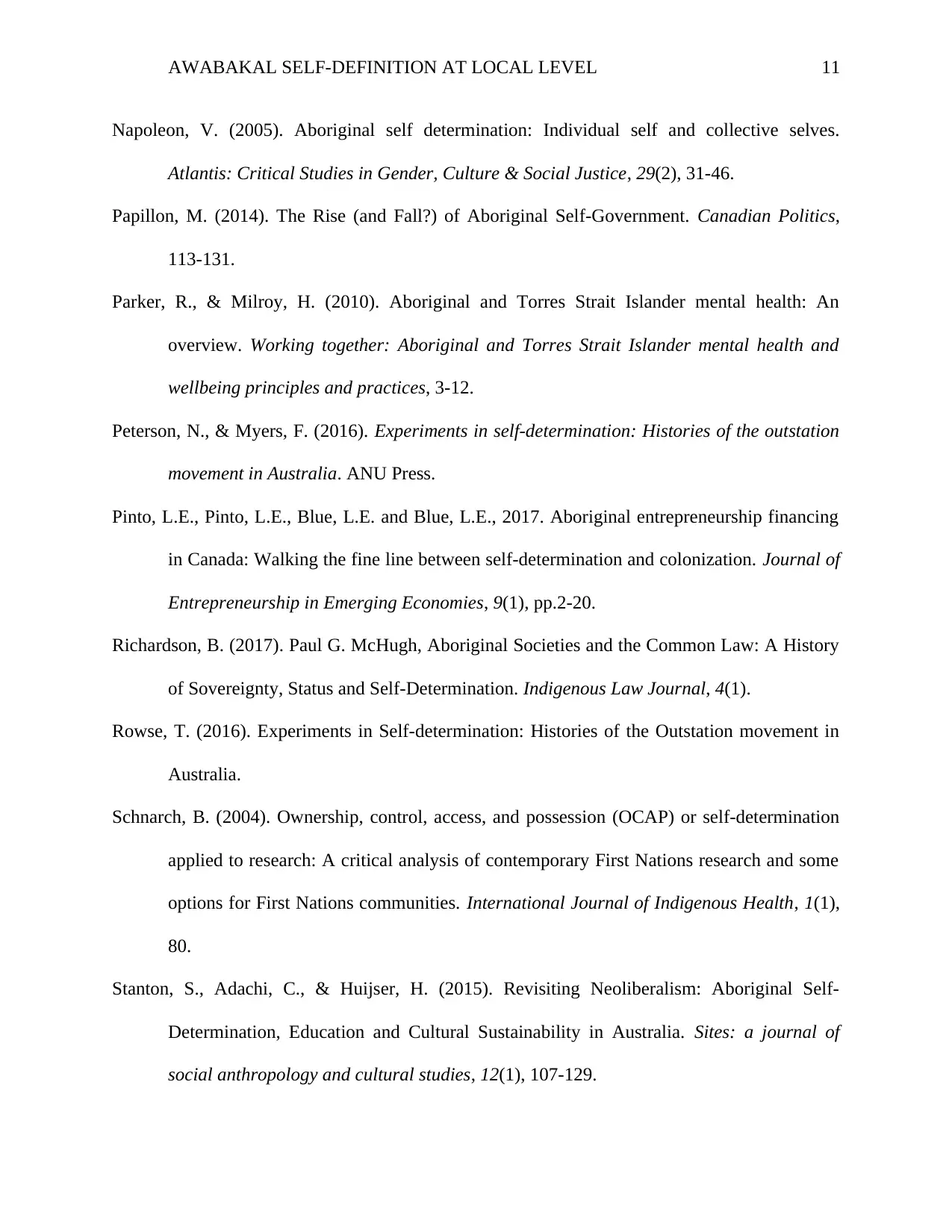
AWABAKAL SELF-DEFINITION AT LOCAL LEVEL 11
Napoleon, V. (2005). Aboriginal self determination: Individual self and collective selves.
Atlantis: Critical Studies in Gender, Culture & Social Justice, 29(2), 31-46.
Papillon, M. (2014). The Rise (and Fall?) of Aboriginal Self-Government. Canadian Politics,
113-131.
Parker, R., & Milroy, H. (2010). Aboriginal and Torres Strait Islander mental health: An
overview. Working together: Aboriginal and Torres Strait Islander mental health and
wellbeing principles and practices, 3-12.
Peterson, N., & Myers, F. (2016). Experiments in self-determination: Histories of the outstation
movement in Australia. ANU Press.
Pinto, L.E., Pinto, L.E., Blue, L.E. and Blue, L.E., 2017. Aboriginal entrepreneurship financing
in Canada: Walking the fine line between self-determination and colonization. Journal of
Entrepreneurship in Emerging Economies, 9(1), pp.2-20.
Richardson, B. (2017). Paul G. McHugh, Aboriginal Societies and the Common Law: A History
of Sovereignty, Status and Self-Determination. Indigenous Law Journal, 4(1).
Rowse, T. (2016). Experiments in Self-determination: Histories of the Outstation movement in
Australia.
Schnarch, B. (2004). Ownership, control, access, and possession (OCAP) or self-determination
applied to research: A critical analysis of contemporary First Nations research and some
options for First Nations communities. International Journal of Indigenous Health, 1(1),
80.
Stanton, S., Adachi, C., & Huijser, H. (2015). Revisiting Neoliberalism: Aboriginal Self-
Determination, Education and Cultural Sustainability in Australia. Sites: a journal of
social anthropology and cultural studies, 12(1), 107-129.
Napoleon, V. (2005). Aboriginal self determination: Individual self and collective selves.
Atlantis: Critical Studies in Gender, Culture & Social Justice, 29(2), 31-46.
Papillon, M. (2014). The Rise (and Fall?) of Aboriginal Self-Government. Canadian Politics,
113-131.
Parker, R., & Milroy, H. (2010). Aboriginal and Torres Strait Islander mental health: An
overview. Working together: Aboriginal and Torres Strait Islander mental health and
wellbeing principles and practices, 3-12.
Peterson, N., & Myers, F. (2016). Experiments in self-determination: Histories of the outstation
movement in Australia. ANU Press.
Pinto, L.E., Pinto, L.E., Blue, L.E. and Blue, L.E., 2017. Aboriginal entrepreneurship financing
in Canada: Walking the fine line between self-determination and colonization. Journal of
Entrepreneurship in Emerging Economies, 9(1), pp.2-20.
Richardson, B. (2017). Paul G. McHugh, Aboriginal Societies and the Common Law: A History
of Sovereignty, Status and Self-Determination. Indigenous Law Journal, 4(1).
Rowse, T. (2016). Experiments in Self-determination: Histories of the Outstation movement in
Australia.
Schnarch, B. (2004). Ownership, control, access, and possession (OCAP) or self-determination
applied to research: A critical analysis of contemporary First Nations research and some
options for First Nations communities. International Journal of Indigenous Health, 1(1),
80.
Stanton, S., Adachi, C., & Huijser, H. (2015). Revisiting Neoliberalism: Aboriginal Self-
Determination, Education and Cultural Sustainability in Australia. Sites: a journal of
social anthropology and cultural studies, 12(1), 107-129.
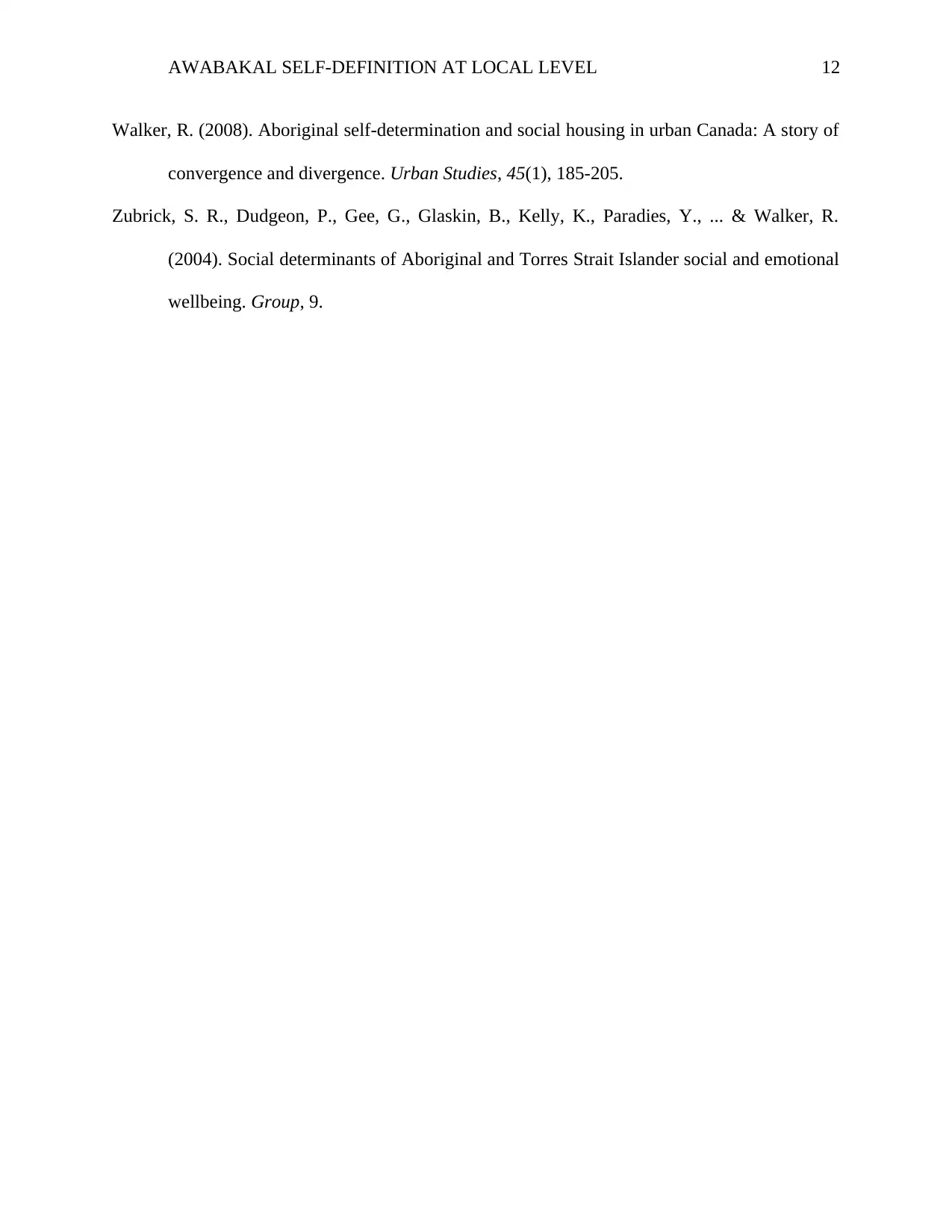
AWABAKAL SELF-DEFINITION AT LOCAL LEVEL 12
Walker, R. (2008). Aboriginal self-determination and social housing in urban Canada: A story of
convergence and divergence. Urban Studies, 45(1), 185-205.
Zubrick, S. R., Dudgeon, P., Gee, G., Glaskin, B., Kelly, K., Paradies, Y., ... & Walker, R.
(2004). Social determinants of Aboriginal and Torres Strait Islander social and emotional
wellbeing. Group, 9.
Walker, R. (2008). Aboriginal self-determination and social housing in urban Canada: A story of
convergence and divergence. Urban Studies, 45(1), 185-205.
Zubrick, S. R., Dudgeon, P., Gee, G., Glaskin, B., Kelly, K., Paradies, Y., ... & Walker, R.
(2004). Social determinants of Aboriginal and Torres Strait Islander social and emotional
wellbeing. Group, 9.
⊘ This is a preview!⊘
Do you want full access?
Subscribe today to unlock all pages.

Trusted by 1+ million students worldwide
1 out of 12
Your All-in-One AI-Powered Toolkit for Academic Success.
+13062052269
info@desklib.com
Available 24*7 on WhatsApp / Email
![[object Object]](/_next/static/media/star-bottom.7253800d.svg)
Unlock your academic potential
Copyright © 2020–2025 A2Z Services. All Rights Reserved. Developed and managed by ZUCOL.